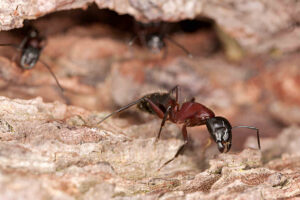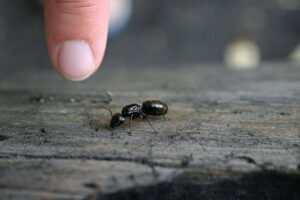How to Get Rid of Carpenter Ants: Protect Your Woodwork Home
Even though carpenter ants don’t eat wood like termites do, they can still do a lot of damage to your home by digging through it. If you know how to get rid of carpenter ants, you can keep your wooden buildings safe and avoid having to pay a lot of money for repairs. This guide gives you steps you can take, ways to prevent problems, and long-term answers that are right for 2025.
What Are Carpenter Ants?
An enormous ant species, the carpenter ant constructs its nests in damp or decomposing wood. Although they construct their colonies in excavated timber, they do not consume it as termites do. Typical indicators of an infestation consist of:
- Sawdust-like stuff (called frass) next to wood surfaces
- Walls making rustling sounds
- When it’s spring, winged ants come inside.
- Wood that sounds hollow when tapped

Why Carpenter Ants Are a Problem
To keep carpenter ants out, you need to keep your house closed up. They can: If nothing is done,
- Break up the joists, studs, and support beams
- You can hide inside walls and ceilings.
- Lower the value of your home.
Methods for Eliminating Carpenter Ants in a Methodical Manner
If carpenter ants have already ruined your wood buildings, you should fix them right away. Our Carpenter Services can help fix up your home’s wood beams, frames, and other important parts so that problems don’t happen again.
1. Identify the Source
Seek out the nest. Determine what to look for:
- Cluttered areas close to walls or window sills.
- Wood that is damp in areas such as basements, attics, or sinks
- Anthills, particularly at night
2. Use Bait Traps
Ant bait traps draw in the poison-carrying ants and keep them from returning to their nests. Boric acid or other tried-and-true substances are good choices for bait stations. Put them where:
- Along ant trails
- Near suspected entry points
- Close to moist areas
3. Apply Insecticide Dust or Foam
Fill holes, cracks, and nest spaces in walls with insecticide dust. Things made of foam can get deeper into the swarm.
Caution: Always wear safety gear and follow the directions on the product.
4. Seal Entry Points
Weatherstripping or glue can be used to seal:
- Wall and base cracks
- There are holes in the doors and windows.
- Utility holes for pipes and wires
5. Remove Attractants
Cut down on the things that ants like:
- Fix lines and roofs that are leaking.
- Firewood should be kept away from the house.
- Cut off tree branches that are near your house.
6. Call a Professional
Get in touch with a professional exterminator if the infestation is severe. They can:
- Finding the primary and secondary nests
- Take precautions while handling chemicals designed for industrial use
- Give methods for prevention that will last

Preventing Future Infestations
- Keep wood dry: In wet places, use dehumidifiers and fix leaks.
- Inspect regularly: Make sure to inspect the basement, attic, and crawl area.
- Landscape smartly: Make sure mulch and plants don’t touch the foundation.
Best Products to Use in 2025
- Terro T300B Liquid Ant Baits
- Bayer Advanced Carpenter Ant & Termite Killer Plus
- Ortho Home Defense Insect Killer Spray
- BASF Alpine Dust Insecticide
- Combat Max Ant Killing Bait
Always buy EPA-approved items, and in 2025, check for changes.
Final Thoughts
To protect your home’s structure, you need to know how to get rid of carpenter ants. To stay safe, you should act quickly, whether you treat yourself or hire someone else to do it. Make sure they don’t do too much damage before you wait. Protect your wooden investment today.
FAQs
Q1: Do carpenter ants have higher activity levels at night?
Indeed, they are nocturnal, and during the warmer months, they are most active at night.
Q2: Is it possible to eradicate carpenter ants without using chemicals?
Natural remedies like essential oils, vinegar sprays, and diatomaceous earth can be used, although they might not be as adequate for severe infestations.
Q3: How long does it take to get rid of a colony of carpenter ants?
It can take anything from a few days to many weeks, depending on the colony’s size and the techniques employed.
Is it true that carpenter ants bite?
Indeed, if they feel threatened, they may bite, and particular species may irritate minor wounds by spraying formic acid.
Q5: Do they pose a threat to people or pets?
Usually not; however, infestations may harm structures, and their bites can hurt.
References
- U.S. Environmental Protection Agency (EPA) – https://www.epa.gov
- University of Kentucky Entomology Department – https://entomology.ca.uky.edu/ef603